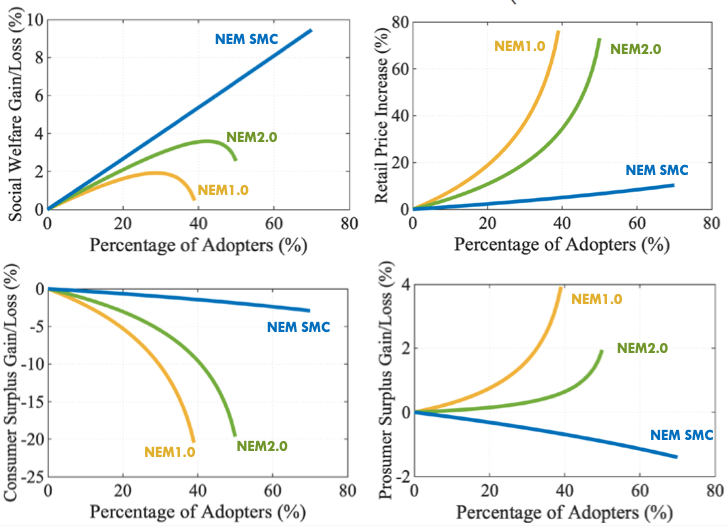I am happy to announce that I have been selected as a MiSK Fellow. Awarded by the MiSK Foundation, the fellowship aims to discover, develop, and connect high potential Saudi youth to become well-rooted, globally competitive, and emboldened to make a positive socioeconomic impact.
New arXiv Preprint
Our paper entitled “Integrating Distributed Energy Resources: Optimal Prosumer Decisions and Impacts of Net Metering Tariffs“ is now available on arXiv:
Paper abstract
The rapid growth of the behind-the-meter (BTM) distributed generation has led to initiatives to reform the net energy metering (NEM) policies to address pressing concerns of rising electricity bills, fairness of cost allocation, and the long-term growth of distributed energy resources. This article presents an analytical framework for the optimal prosumer consumption decision using an inclusive NEM X tariff model that covers existing and proposed NEM tariff designs. The structure of the optimal consumption policy lends itself to near closed-form optimal solutions suitable for practical energy management systems that are responsive to stochastic BTM generation and dynamic pricing. The short and long-run performance of NEM and feed-in tariffs (FiT) are considered under a sequential rate-setting decision process. Also presented are numerical results that characterize social welfare distributions, cross-subsidies, and long-run solar adoption performance for selected NEM policy designs.
Paper link:
https://arxiv.org/abs/2204.06115v1
Recent Publication in the IEEE Transactions on Smart Grid
Our paper “On Net Energy Metering X: Optimal Prosumer Decisions, Social Welfare, and Cross-Subsidies“ has been published in the IEEE Transactions on Smart Grid.
The work formalizes the prosumer decision problem under net metering and provides a closed-form characterization of the prosumer consumption decisions. Key structural properties and intuition are acquired from the derived and apriori computed threshold policy.
The paper abstract is given below:
“We introduce NEM X, an inclusive retail tariff model that captures features of existing net energy metering (NEM) policies. It is shown that the optimal prosumer decision has three modes: (a) the net-consuming mode where the prosumer consumes more than its behind-the-meter distributed energy resource (DER) production when the DER production is below a predetermined lower threshold, (b) the net-producing mode where the prosumer consumes less than its DER production when the DER production is above a predetermined upper threshold, and (c) the net-zero energy mode where the prosumer's consumption matches to its DER generation when its DER production is between the lower and upper thresholds. Both thresholds are obtained in closed-form. Next, we analyze the regulator's rate-setting process that determines NEM X parameters such as retail/sell rates, fixed charges, and price differentials in time-of-use tariffs' on and off-peak periods. A stochastic Ramsey pricing program that maximizes social welfare subject to the revenue break-even constraint for the regulated utility is formulated. Performance of several NEM X policies is evaluated using real and synthetic data to illuminate impacts of NEM policy designs on social welfare, cross-subsidies of prosumers by consumers, and payback time of DER investments that affect long-run DER adoptions.“
New Article: "Does CPUC’s PD (NEM 3.0) Stall Rooftop Solar Adoption?"
A new blog article is added to my medium page: “Does CPUC’s PD (NEM 3.0) Stall Rooftop Solar Adoption?”
Have a read at: Does CPUC’s PD (NEM 3.0) Stall Rooftop Solar Adoption?
My medium webpage can be reached by clicking the green icon below.
PSERC Presentation: On Net Metering Policies: Welfare and Subsidy Analysis
Our work entitled “ On Net Energy Metering X: Optimal Prosumer
Decisions, Social Welfare, and Cross-subsidies“ was presented at PSERC (Presentation, ArXiv).
The presentation was well attended with over 210 attendees!
An abstract of the work is given below:
We introduce NEM X, an inclusive retail tariff model that captures features of existing net energy metering (NEM) policies. It is shown that the optimal prosumer decision has three modes: (a) the net-consuming mode where the prosumer consumes more than its behind-the-meter distributed energy resource (DER) production when the DER production is below a predetermined lower threshold, (b) the net-producing mode where the prosumer consumes less than its DER production when the DER production is above a predetermined upper threshold, and (c) the net-zero energy mode where the prosumer's consumption matches to its DER generation when its DER production is between the lower and upper thresholds. Both thresholds are obtained in closed-form. Next, we analyze the regulator's rate-setting process that determines NEM X parameters such as retail/sell rates, fixed charges, and price differentials in ToU tariffs' on and off-peak periods. A stochastic Ramsey pricing program is formulated that maximizes social welfare subject to the revenue break-even constraint for the regulated utility. Performance of NEM X policies is evaluated using real and synthetic data to illuminate impacts of NEM policy designs on social welfare, cross-subsidies of prosumers by consumers, and payback time of DER investments that affect long-run DER adoptions.
New Paper Published In IEEEXplore
Our paper titled: Hybrid Top-Down and Bottom-Up Approach for Residential Load Compositions and Percentages. is now published in IEEEXplore.
New Article: “Exposing Electricity Customers to Spot Prices — A Lesson From Griddy”
A new article is published, titled “Exposing Electricity Customers to Spot Prices — A Lesson From Griddy “
The article can be accessed at: Medium.
New Article: "A Netflix-Subscription-Like Electricity Bill"
I just published “A Netflix-Subscription-Like Electricity Bill“. The link to access the article is: Here.
Hope you enjoy reading it.
On The Regressiveness of Net Metering (New Article Post)
You can check my latest article on “ The Switcheroo In The Retail Electricity Market - Questioning Net Metering Regressiveness“
The article is also available on Medium:
Accepted Conference Paper at PSGEC2021
Our conference paper entitled “Hybrid Top-Down and Bottom-Up Approach for Investigating Residential Load Compositions and Load Percentages“ is accepted at the 2021 Power System And Green Energy Conference (PSGEC 2021), Shanghai, China
The paper is abstract is given below:
Load points are one of the most vital parts of power systems. Due to the new load forms and programs introduced in the demand side, the load serving entities (LSEs) no longer deal with lump loads, but rather with more dynamic, rational and price elastic loads. The high inter-temporal and behavioral variability of the load profile makes it almost impossible for utilities and system operators to expect the demand curve with the needed accuracy. A sound granularity of the load compositions and consumption percentages and patterns throughout the year is essential for avoiding energy losses, designing demand side management (DSM) programs and ensuring proper adjustments of electricity rates. In this paper, a simplistic model that can be followed by system operators to initially understand the customers consumption pattern and the household load structure is proposed. A top-down approach is combined and matched with a detailed bottom-up one, to extract load compositions and percentages. Real and local load profiles integrated with household statistical data such as device time of use (ToU), number of device units per house and activities exercised in households are all included in the model. The main results of the paper show the load composition in residential demand and the percentage of such composition under seasonal-based scenarios.
New Journal Paper Published
A new journal, which is part of a chapter in my M.Sc thesis is now published at the IET Journal of Engineering (JoE).
The article title is: “Incentive-Based Feasibility of a Hybrid AC/DC Microgrid in Saudi Arabia“
Attended The 2020 IEEE SmartGridComm Conference
I attended the IEEE 2020 IEEE International Conference on Communications, Control, and Computing Technologies for Smart Grids (SmartGridComm), which was held between 11-13th November 2020.
I also volunteered at the conference as a Zoom moderator for multiple sessions.
Presentation at INFROMS 2020 Annual Meeting
I am delighted to present our paper entitled “ An intelligent load priority list–based integrated energy management system in microgrids“ at the INFORMS 2020 Annual Meeting.
I would like to thank SangWoo Park from UC Berkeley for his kind invitation.
New Journal Paper Published
A new journal paper, which is part of my M.Sc thesis, is now published at Electric Power System Research (EPSR) journal. To access the full paper, please follow the link (here)
A paper is now indexed in IEEEXplore
The following paper is indexed in IEEEXplore now:
A. Alahmed, S. Taiwo and M. Abido, "Implementation and Evaluation of Grey Wolf optimization Algorithm on Power System Stability Enhancement," 2019 IEEE 10th GCC Conference & Exhibition (GCC), Kuwait, Kuwait, 2019, pp. 1-6. doi: 10.1109/GCC45510.2019.1570512680 [Link]
Attended KFUPM Forum About Challenges Facing Education In The Age of COVID19
The moderator of the forum was Prof. Muhammad Al-Saggaf, president of KFUPM.
Speakers:
Prof. Nam Suh, Former President, KAIST, Korea
Prof. Tony Chan, President, KAUST, KSA
Prof. Charles Elachi, Former Director, JPL
Prof. Martin C. Jischke, President Emeritus, Purdue University
Attended the 2019 PSERC IAB Meeting
Pleased to attend the PSERC Industry Advisory Board Meeting (IAB) that was held in Richmond, VA between 4 - 6 of December. The meeting gathered industry members, faculty, and students who are interested in power system engineering. Challenges and opportunities in electrification, decarbonization and digitalization were discussed. I enjoyed the informal networking opportunities with the top-notch researchers in the meeting.
Many thanks to my advisor Professor. Tong for enabling me to participate. The thanks are also extended to Dominion Energy Company and Dr. Anna Rosa Lampis for the great organization of the event.
A Paper is Now Indexed in IEEE Explore
Our paper titled “
Intelligent Flexible Priority List for Reconfiguration of Microgrid Demands Using Deep Neural Network“
is now available on IEEE Explore under this link (Click)
Successfully Defended my MS Thesis at King Fahd University of Petroleum and Minerals (KFUPM)
I successfully defended my MS thesis at King Fahd University of Petroleum and Minerals (KFUPM).
Thesis Title: “ Integrated Energy Management System for Microgrids with Hybrid Renewable Generation, Energy Storage and Controllable Loads”
Won at KFUPM 10th Student Scientific Forum (SSF)
My paper titled “ Intelligent Flexible Priority List for Reconfiguration of Microgrid
Demands Using Deep Neural Network ” won the second rank in Scientific Research Track






















